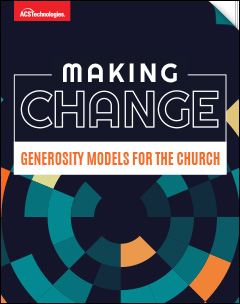“Fundraising is, first and foremost, a form of ministry. It is a way of announcing our vision and inviting other people into our mission.”
These words from theologian Henri Nouwen (and his transformational work, The Spirituality of Fundraising) serve to remind me of our role as pastors, ministry leaders and those who do development work in the church. This is ministry.
In this blog series, we’ve been exploring Biblical generosity models that can reframe our strategies and thinking about donor stewardship. We’ve looked at how we approach and manage change and ways we can creatively engage donors in our congregations.
In our final post today, we close by re-centering ourselves in the reasons we invite donors to support our church and our ministry. Donors need ministry more than we need their money, and donors whose needs are met become long-term and generous supporters.
Biblical Generosity Model #4: GENEROUS PEOPLE GIVE TO SEE THE IMPOSSIBLE BECOME POSSIBLE
For example, a little boy offered Jesus his meager lunch in Matthew 14:14– 21. In this case, he only had a few loaves and fishes, and Jesus had 5,000+ mouths to feed. But as we know in this familiar story of our faith, gifts in God’s hands can be — and often are— divinely multiplied to meet the demands of greater works.
This is one of the greatest-ever giving stories. It is a beautiful picture of the faith to see something profound happen because of your gifts. First and foremost, the young man had enough faith to give his own lunch away! He was risking his own provision, his own comfort, in the hope of helping others. One boy’s faith is what set in motion the amazing miracle of Jesus feeding the masses.
We have to be willing to imagine something much greater than ourselves in order to get behind a project. It can be difficult for a prospective donor to comprehend how it could possibly come together.
Yet almost daily across ministries and churches, I encounter the miraculous— in responses from generous givers, people from all economic demographics. They are turning what seems impossible into the possible.
Our job as pastors and ministry leaders is to cast the vision God has called us into and invite others into that sacred space of making what otherwise might be impossible, possible.
As Nouwen so beautifully reminds us, our job is not to operate out of crisis or beg for funding. “Rather, we are declaring, ‘We have a vision that is amazing and exciting. We are inviting you to invest yourself through the resources that God has given you— your energy, your prayers, and your money—in this work to which God has called us.’ Our invitation is clear and confident because we trust that our vision and mission are like ‘trees planted by streams of water, which yield their fruit in its season, and their leaves do not wither’ (Ps. 1:3).
“Fundraising is also always a call to conversion. And this call comes to both those who seek funds and those who have funds. Whether we are asking for money or giving money we are drawn together by God, who is about to do a new thing through our collaboration.”
Conclusion – Making Change: Generosity Models for the Church
Pastors, in day-to-day practice, this comes down to relationships and communication. It means ensuring your members and donors hear in various ways. Across multiple channels, platforms, and from various people – the transformational impact their gifts have on the Kingdom of God. As we enter a new calendar year, it’s a good time to look strategically at your communications calendar. And how to gather and tell those stories of impact.
Keep what your donors are making possible in front of them regularly. Celebrate “the new thing” they are doing with you in collaboration. Doing so inspires them, inspires others to give, and keeps you as church leaders energized for your particular mission.
Does your church’s donor engagement plan need a revamp?
These easy-to-implement strategies get their inspiration from the models of generosity we find in scripture. Inspire your staff and your church’s donors by taking a look at best practices in leadership alongside some of the Bible’s most poignant lessons about giving as you freshen your stewardship plans.
Tim Smith has over 30 years of experience in Church, Non-Profit Administration, Management, and Fund Development. Serving as an Executive Pastor and Chief Development Officer in growing Churches and Non-Profit Organizations has provided a wide range of expertise and resources. Tim serves as Founder and CEO of Non-Profit DNA. A boutique firm committed to helping nonprofits and churches build their capacity through fundraising, leadership, team building, staff recruiting, and coaching.





